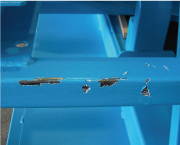E-Archive
From the World of Blasting
in Vol. 25 - January Issue - Year 2024
Tackling Sticky Dust in Abrasive Blasting

Coating Failure Caused by Oil Contamination

Water Penetration Test
It is common knowledge in the abrasive blasting industry, that dust and fines left in abrasive increase the wear of wheel components and the machine itself. We also know that an unbalanced operating mix with dust and fines decreases the efficiency of cleaning of parts. The air wash separator, set properly, is designed to remove these fines and dust into the discharge or the dust collection system and keep the operating mix at a balanced state to provide optimal energy transfer and coverage. But what if the fines and dust cannot be removed, no matter how efficient the separation and dust collection is? How can this happen, you ask? When the dust and fines are “stuck” in larger particles of abrasive, they ride through the air wash and end up going back to the blast machine. This “sticky” dust is caused by oily residues in the abrasive that coat the abrasive and cause small particles to stick to larger particles, making them too heavy to be removed.
Oil and grease can get into the abrasive blast system in several ways. It could enter from a pressing or forging operation where oil and lubricants are used in the operation prior to blasting. It could enter from grease and oil used around and on the machine. Regardless of the specific way, oil can disrupt the blast system, leaving behind dust and oily residues on blasted parts. This will lead to adhesion issues for the coating. Even if you do not coat blasted parts, the dust and fines left in your operating mix will greatly increase the wear of your machine components. In fact, based on industry observations, even a slight increase in dust by 2% can lead to as much as a 50% increase in component wear. This “sticky” dust will also clog your dust collection filtration system in a short time and increase the risk of fire.
So how do you remove this residue and keep the operating mix clean and balanced? Even with the best process controls prior to blasting, preventing the ingress of oily residue is nearly impossible. Adding an additive, designed to bind with oily residue and remove it from the system, is an ideal prophylactic measure. These additives mechanically bind with oil, removing it from the abrasive and surfaces, and then are removed through the air wash system, leaving behind the oil-free abrasive, and preventing the dust and fines from sticking to larger particles of the abrasive. What is left is a clean, dust-free abrasive mix that, along with a balanced separation system, provides optimal cleaning, coating-ready parts.
Other benefits of these additives include lower overall costs of surface preparation. By having coating-ready parts straight from the blast operation, you eliminate the need for costly chemical wash systems prior to paint. Additionally, maintenance cost, energy consumption, and downtime are all reduced. Increase in production is possible due to these lowered factors. And, perhaps the greatest benefit of all, fire risk is decreased because of the inert characteristics of the additive.
In conclusion, keeping the abrasive clean and oil free does not just benefit the surface prep and coating industry. Other users of abrasive blasting can also benefit from oil-free abrasives. Remember, an ounce of prevention is worth a pound of cure.
Contact: chris.prouty@winoa.com
Contributing Editor for MFN and Technical Advisor at Winoa



























